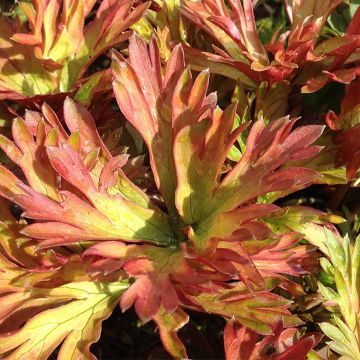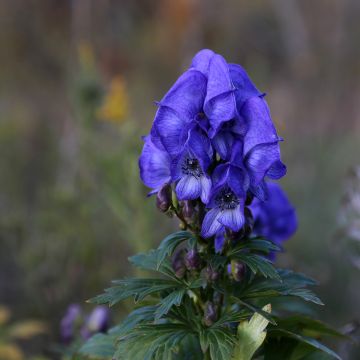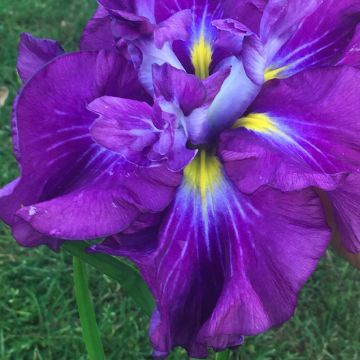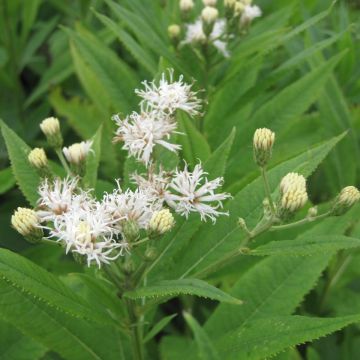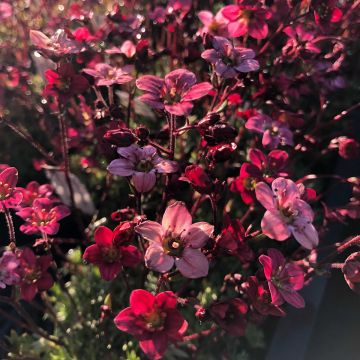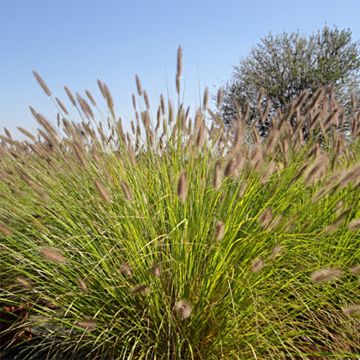

Aconitum Purple Sparrow
Aconitum Purple Sparrow
Aconitum lamarckii x septentrionale Purple Sparrow
Monkshood, Wolfsbane, Aconite
This item cannot be shipped to the selected country
Delivery charge from €5.90
More information
Schedule delivery date,
and select date in basket
This plant carries a 12 months recovery warranty
More information
We guarantee the quality of our plants for a full growing cycle, and will replace at our expense any plant that fails to recover under normal climatic and planting conditions.
From €5.90 for pickup delivery and €6.90 for home delivery
Express home delivery from €8.90.
Does this plant fit my garden?
Set up your Plantfit profile →
Description
The Aconitum 'Purple Sparrow' is a hybrid aconite with a compact habit and vigorous growth, and a perpetual flowering from late spring to the end of summer, often with a small pause during the peak of summer. This well-coloured variety produces branched spikes of purplish flowers touched with pale yellow, dominating a clump of thick, glossy, palmate leaves. Preferring cool and rich soils, this perennial is a reliable and floriferous plant, thriving in gently sunny borders, partial shade, or even not too dense shade.
This recent horticultural variety was obtained from the Netherlands. It is presented by its breeder as resulting from the cross-breeding between an Aconitum lamarckii, native to the mountainous regions of central and southern Europe, Morocco, and A. septentrionale, which is native to the forests of northern Europe. All aconites belong to the Ranunculaceae family. The flowering plant measures about 60 cm (24in) in height, with a width of 50 to 60 cm (20 to 24in). The flowering of this variety starts in June, continues through July, often pauses in August, and resumes in September, depending on the climate. If the soil remains cool in summer, it will bloom from late June to August-September. Clumps of leaves emerge from the branched, vertical, dark-coloured flower stalks. Its elongated helmet-shaped flowers consist of a purple corolla veined with darker shades, revealing a pale yellow interior. This plant develops from a fleshy tuberous stump, from which an erect clump of sparsely hairy stems emerges in spring, adorned with tough, palmate leaves, deeply lobed and strongly toothed along the edges. They are deeply veined, with a very dark green colour and a slight gloss. All parts of this perennial are highly toxic.
Aconites have a bad reputation in gardens due to their legendary toxicity, which is unfortunate because these ornamental plants have their place in all gardens. They are robust, very hardy, and their foliage is among the most beautiful of all perennial plants. Not to mention their vibrant flowering, ranging from almost white to gentian blue. They are perfect in borders, among grasses, and in the company of asters and chrysanthemums for magical autumn scenes. They can be planted among bushes, in the company of Japanese anemones, especially this 'Purple Sparrow' variety that appreciates light shade. These plants also look stunning in front of the autumn foliage of Persian ironwood or deciduous euonymus. They are good perennials, like foxgloves, for light and cool woodland areas. Finally, their flowers are magnificent in bouquets.
Report an error about the product description
Aconitum Purple Sparrow in pictures




Flowering
Foliage
Plant habit
Safety measures
Botanical data
Aconitum
lamarckii x septentrionale
Purple Sparrow
Ranunculaceae
Monkshood, Wolfsbane, Aconite
Cultivar or hybrid
ingestion
Cette plante est toxique si elle est ingérée volontairement ou involontairement.
Ne la plantez pas là où de jeunes enfants peuvent évoluer, et lavez-vous les mains après l'avoir manipulée.
Pensez à conserver l'étiquette de la plante, à la photographier ou à noter son nom, afin de faciliter le travail des professionnels de santé.
Davantage d'informations sur https://plantes-risque.info
Other Aconitum
Planting and care
The 'Purple Sparrow' aconites thrive in light undergrowth, in a sheltered position away from strong winds. They appreciate a deep, moist soil, rich in humus, acidic to neutral, or without excess limestone. In full sun, the soil must remain constantly moist and never dry out. For this reason, it is recommended to use mulch in summer to maintain some freshness. The soil that welcomes it will be enriched with compost, leaf soil and turf, which will give it a slight acidity. However, this variety is quite accommodating and will thrive in good garden soil that remains slightly cool in summer.
Planting period
Intended location
Care
This item has not been reviewed yet - be the first to leave a review about it.
Summer flowering perennials
Haven't found what you were looking for?
Hardiness is the lowest winter temperature a plant can endure without suffering serious damage or even dying. However, hardiness is affected by location (a sheltered area, such as a patio), protection (winter cover) and soil type (hardiness is improved by well-drained soil).

Photo Sharing Terms & Conditions
In order to encourage gardeners to interact and share their experiences, Promesse de fleurs offers various media enabling content to be uploaded onto its Site - in particular via the ‘Photo sharing’ module.
The User agrees to refrain from:
- Posting any content that is illegal, prejudicial, insulting, racist, inciteful to hatred, revisionist, contrary to public decency, that infringes on privacy or on the privacy rights of third parties, in particular the publicity rights of persons and goods, intellectual property rights, or the right to privacy.
- Submitting content on behalf of a third party;
- Impersonate the identity of a third party and/or publish any personal information about a third party;
In general, the User undertakes to refrain from any unethical behaviour.
All Content (in particular text, comments, files, images, photos, videos, creative works, etc.), which may be subject to property or intellectual property rights, image or other private rights, shall remain the property of the User, subject to the limited rights granted by the terms of the licence granted by Promesse de fleurs as stated below. Users are at liberty to publish or not to publish such Content on the Site, notably via the ‘Photo Sharing’ facility, and accept that this Content shall be made public and freely accessible, notably on the Internet.
Users further acknowledge, undertake to have ,and guarantee that they hold all necessary rights and permissions to publish such material on the Site, in particular with regard to the legislation in force pertaining to any privacy, property, intellectual property, image, or contractual rights, or rights of any other nature. By publishing such Content on the Site, Users acknowledge accepting full liability as publishers of the Content within the meaning of the law, and grant Promesse de fleurs, free of charge, an inclusive, worldwide licence for the said Content for the entire duration of its publication, including all reproduction, representation, up/downloading, displaying, performing, transmission, and storage rights.
Users also grant permission for their name to be linked to the Content and accept that this link may not always be made available.
By engaging in posting material, Users consent to their Content becoming automatically accessible on the Internet, in particular on other sites and/or blogs and/or web pages of the Promesse de fleurs site, including in particular social pages and the Promesse de fleurs catalogue.
Users may secure the removal of entrusted content free of charge by issuing a simple request via our contact form.
The flowering period indicated on our website applies to countries and regions located in USDA zone 8 (France, the United Kingdom, Ireland, the Netherlands, etc.)
It will vary according to where you live:
- In zones 9 to 10 (Italy, Spain, Greece, etc.), flowering will occur about 2 to 4 weeks earlier.
- In zones 6 to 7 (Germany, Poland, Slovenia, and lower mountainous regions), flowering will be delayed by 2 to 3 weeks.
- In zone 5 (Central Europe, Scandinavia), blooming will be delayed by 3 to 5 weeks.
In temperate climates, pruning of spring-flowering shrubs (forsythia, spireas, etc.) should be done just after flowering.
Pruning of summer-flowering shrubs (Indian Lilac, Perovskia, etc.) can be done in winter or spring.
In cold regions as well as with frost-sensitive plants, avoid pruning too early when severe frosts may still occur.
The planting period indicated on our website applies to countries and regions located in USDA zone 8 (France, United Kingdom, Ireland, Netherlands).
It will vary according to where you live:
- In Mediterranean zones (Marseille, Madrid, Milan, etc.), autumn and winter are the best planting periods.
- In continental zones (Strasbourg, Munich, Vienna, etc.), delay planting by 2 to 3 weeks in spring and bring it forward by 2 to 4 weeks in autumn.
- In mountainous regions (the Alps, Pyrenees, Carpathians, etc.), it is best to plant in late spring (May-June) or late summer (August-September).
The harvesting period indicated on our website applies to countries and regions in USDA zone 8 (France, England, Ireland, the Netherlands).
In colder areas (Scandinavia, Poland, Austria...) fruit and vegetable harvests are likely to be delayed by 3-4 weeks.
In warmer areas (Italy, Spain, Greece, etc.), harvesting will probably take place earlier, depending on weather conditions.
The sowing periods indicated on our website apply to countries and regions within USDA Zone 8 (France, UK, Ireland, Netherlands).
In colder areas (Scandinavia, Poland, Austria...), delay any outdoor sowing by 3-4 weeks, or sow under glass.
In warmer climes (Italy, Spain, Greece, etc.), bring outdoor sowing forward by a few weeks.




































